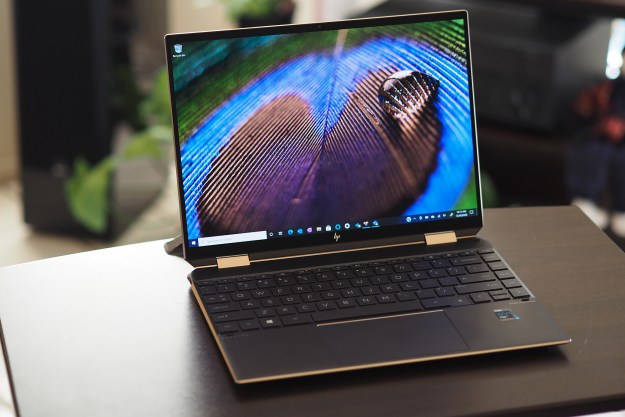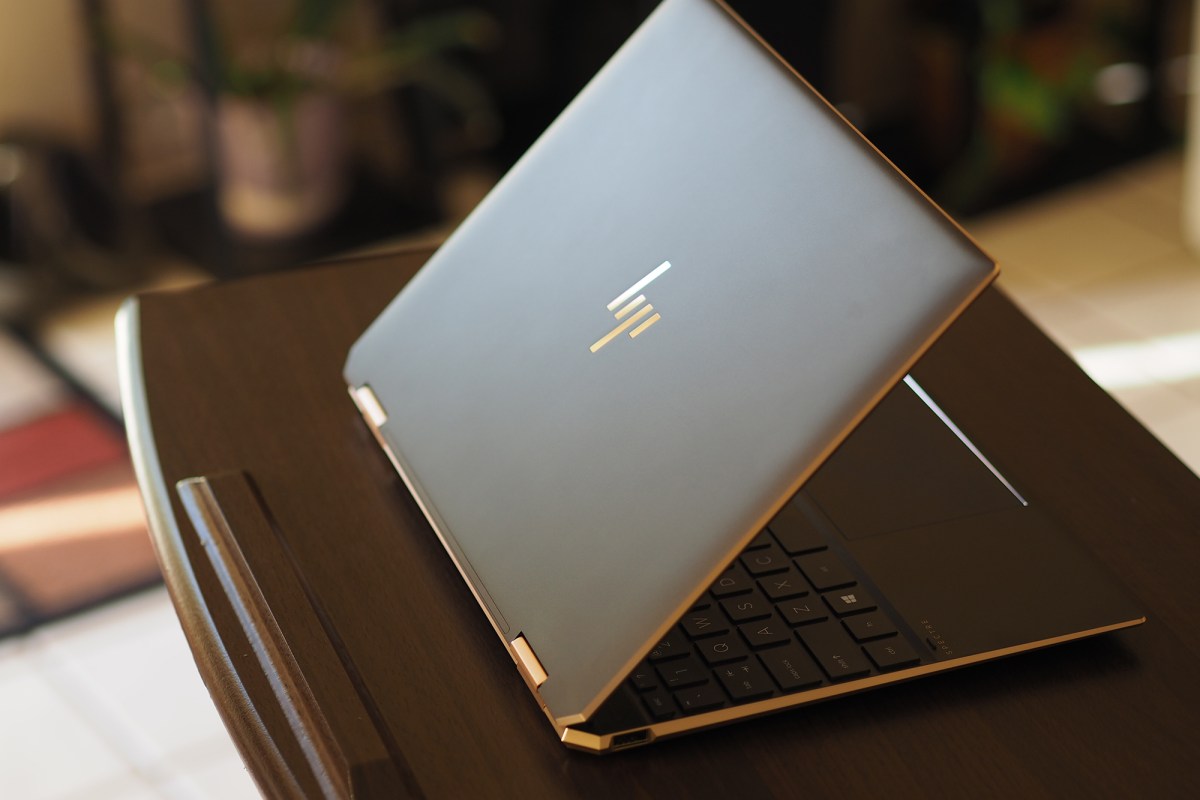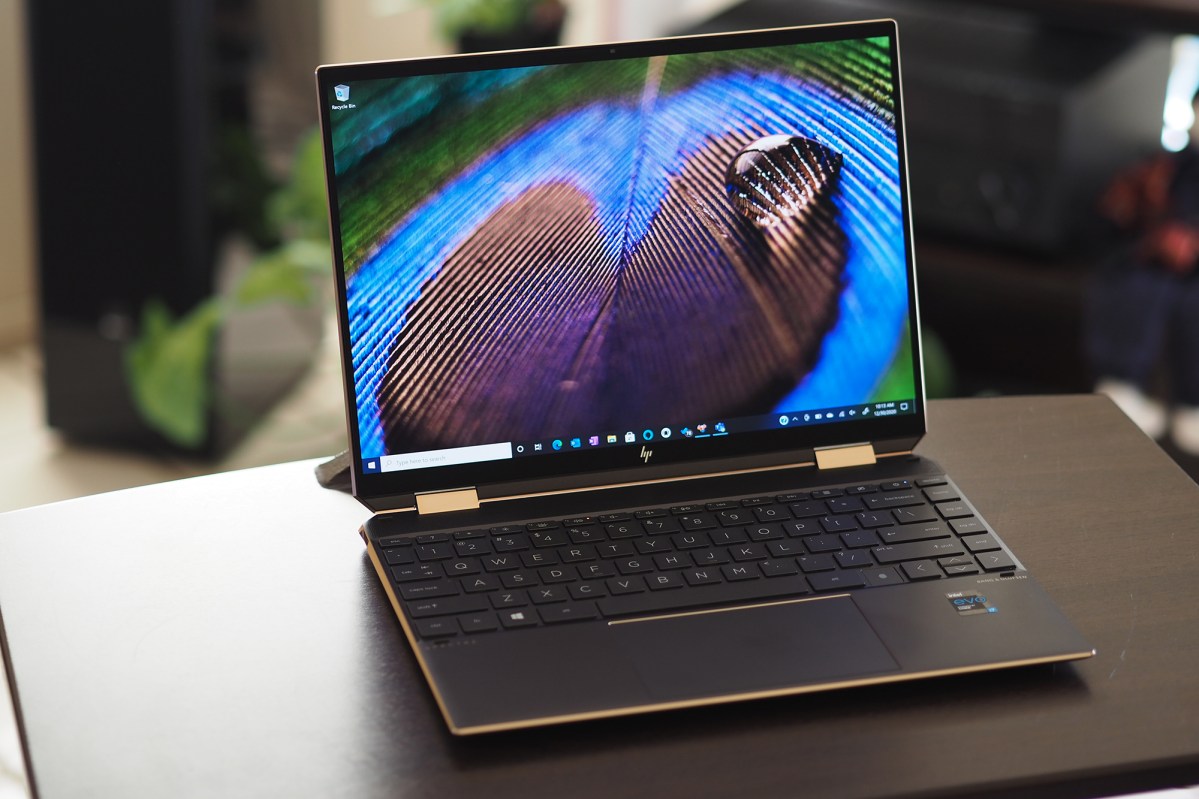
- Spectactular 3:2 OLED display
- Quite speedy in Performance mode
- Surprisingly decent battery life given the display
- Awesome keyboard and touchpad
- Elegant and modern good looks
- Requires some management to balance performance and fan noise
The HP Spectre x360 13 has been one of the top laptops for a while. With its OLED screen and gorgeous design, it was everything I wanted in a convertible 2-in-1 laptop.
But with the competition fierce, HP couldn’t rest on its laurels. Expectations around performance, portability, and size are constantly in flux, and HP’s latest Spectre 2-in-1 attempts to push its design into the future.
The Spectre x360 14 leverages a larger 13.5-inch, 3:2 aspect ratio display, two trends that promise improved productivity. The company sent me a review unit with an 11th-gen Intel Tiger Lake Core i7-1165G7, 16GB of RAM, a 1TB solid-state drive (SSD). It also has a 3,000 x 2,000 resolution OLED display and is priced at $1,700 at Best Buy . I’ve now spent some quality time with the Spectre x360 14, and you know what? HP just may have perfected the 2-in-1 convertible.
Design

HP didn’t mess with the Spectre’s overall design theme — and why would it? The gem-cut aesthetic remains the boldest design you’ll find outside of gaming laptops, although the Spectre is more elegant than ostentatious. The Spectre x360 14 is a beautiful laptop without being over the top, whether in the Nightfall Black color with copper accents that I received or the Poseidon Blue or Natural Silver alternatives.
The Dell XPS 13 is a good-looking laptop as well, but it’s a simpler aesthetic that doesn’t seek to attract attention. Which is better comes down to taste, of course, but I prefer the suave Spectre x360 14.
It’s also very well-built, with zero flexing, bending, or twisting anywhere in the lid, chassis, or keyboard deck. The Spectre x360 14 matches the XPS 13 and the Apple MacBook Pro 13 in this regard, which is high praise. There are only a few other laptops in the class that can equal these three. The XPS 13 does score some points for its dual-zone hinge that can be opened easily with one hand and then holds firmly in place, but the Spectre x360 14 isn’t far behind.
The Spectre’s hinge is almost light enough to open with one hand, and it does a commendable job of holding the display firmly in whichever of its four modes — clamshell, tent, media, or tablet — you choose. The 3:2 aspect ratio display makes tablet mode much more comfortable, with the panel more closely matching an 8.5- x 11-inch piece of paper — credit Microsoft here, given that its Surface line has enjoyed the same aspect ratio for several generations.

The display does alter the Spectre x360 14’s dimensions, making it quite a bit deeper (8.67 inches) than the 13-inch model (7.66 inches) but not quite as wide (11.75 inches versus 12.08 inches). Compared to the tiny-bezeled XPS 13 at 11.64 inches wide and 7.82 inches deep, the Spectre x360 14 is again deeper, even though it has its own small bezels.
It’s the larger chin compared to the XPS 13 that makes the Spectre x360 14 seem so much taller when opened (beyond the sheer height of the 3:2 aspect ratio). The 14-inch is equal to the 13-inch at 0.67 inches thick, both of which exceed the XPS 13’s 0.58 inches, and the Spectre x360 14 is also the heaviest at 2.95 pounds versus the 13-inch and XPS 13, both of which weigh 2.8 pounds.
As I’ve used the Spectre x360 14, I’ve come to appreciate its extra size. Both the Spectre x360 13 and the XPS 13 felt small at times, particularly when it comes to the wrist rest and touchpad — both of which are quite a bit larger on the Spectre x360 14. I find this model to be a solid compromise between the diminutive 13-inch laptops and the hefty Spectre x360 15.

As with the Tiger Lake version of the Spectre x360 13, the 14-inch version has two USB Thunderbolt 4 ports on the right-hand side, one on the edge and one embedded in the notch underneath the display. There’s also a 3.5mm audio jack and miniSD card reader on this side of the chassis. On the other side is the single USB-A 3.1 port. One difference from the 13-inch model is that the power button is no longer in the other notch — this time, it’s on the keyboard, which is a bummer for anyone who uses their laptop closed with an external display.
Now, you must open the lid to turn the laptop on. Although some people might prefer having all the buttons readily available on the keyboard, that’s a regression in my book. Wireless connectivity is modern, with Wi-Fi 6 and Bluetooth 5.
Software
Before I delve into the Spectre x360 14’s performance, let’s talk a little about software. Most manufacturers have developed utilities that let users adjust the CPU clock and fan speed to dial in performance versus heat and fan noise. In some cases, those utilities don’t do much — run a benchmark in the quiet/cool mode and then run it in performance mode, and you’ll see at most a negligible improvement in speed. And quite often, you can’t tell the difference in fan noise or heat.
HP’s Command Center is different, at least in the 13- and 14-inch models (the utility doesn’t help much with the 15-inch Spectre). Toggle “Balanced” mode and the Spectre x360 14 is significantly quieter and cooler, and it’s also quite slow. It falls behind other Tiger Lake Core i7 laptops (and some 1oth-gen laptops) in this mode, but it runs silently and can be comfortably used on a lap. However, toggle “Performance” mode, and the Spectre x360 14 sprouts wings and becomes quite competitive — along with being significantly louder and hotter.
I don’t mention these utilities in my reviews unless they make a meaningful difference in performance. I’m mentioning HP’s Command Center specifically because I don’t want to leave anyone with the impression that this is a slow laptop. It’s not — you just need to make judicious use of the utility. That can either be a bother or a boon, depending on how much attention you want to pay to such things. I like Command Center, because most of the time I don’t need superfast performance and appreciate cool and quiet performance more — but when I need pure speed, it’s just a mouse click away.

I’ll also note that HP has added a few new wrinkles to the utility suite. For example, Command Center itself has a new “Smart Sense” mode that’s supposed to handle things automatically based on the application, the laptop’s placement, and the battery status. I didn’t find it to be particularly smart — “Balanced” mode kept things quieter and “Performance” mode was faster. HP has also added in a Focus Mode that highlights the active application and puts the rest of the display in shadow — it’s an interesting effect, but so far, I’ve just found it distracting. Next, the system has some way to detect if it’s in a bag and avoids waking up — I carried it around in my backpack for a little while and it stayed asleep, but that’s not much of a test.
Then there are a couple of utilities to control the display. One is a stand-alone Display Control utility that lets you set the color profile for your usage. Then there’s a System setting in the display section that lets you turn on adaptive color, which adjusts the color profile based on ambient lighting. It’s like automatic brightness, only for colors. Whether any of these utilities are of value or constitute extra fluff will come down to individual tastes.
Performance
Now, let’s get down to performance, starting with our Handbrake test that encodes a 420MB video as H.265. The Spectre x360 14 took just under four minutes to complete the test in Balanced mode, and just over three minutes in Performance mode. That’s nearly a full minute’s difference by simply flipping the switch. Compared to other Tiger Lake laptops, the Balanced mode score is slower — the Dell XPS 13 9310, for example, took 30 seconds less in its own quiet mode, versus being three seconds faster than the Spectre in both laptop’s performance modes. The Lenovo Yoga 7i 14 with a Core i5-1135G7 was also about 30 seconds faster in Balanced mode, and the Acer Swift 5 matched the Spectre x360 14’s Performance mode results.
Cinebench R23 was similar. The Spectre x360 14 scored a strong 4,847 multi-core in Performance mode versus an anemic 3,941 in Balanced mode. In Performance mode, only the Porsche Design Acer Book RS (a curiously fast Core i5-1135G7 that scored 4,973) and the MSI Prestige 14 Evo with a Core i7-1185G7 (5,789) scored higher among Tiger Lake laptops. The Apple MacBooks with the Apple M1 chip were much faster (6,680 or higher), as were machines running 45-watt Intel H-series CPUs.

I also ran the PCMark 10 Complete test, where, interestingly, Command Center mattered much less. The Spectre x360 14 scores 4,728 in Balanced mode and 4,795 in Performance mode, and the Essentials (web browsing, videoconferencing, app startup), Productivity (spreadsheet and word processing), and Creation (photo editing, video rendering and playback, and video editing) scores were similarly close.
Nevertheless, the Spectre was competitive with other Tiger Lake laptops, beating out the Porsche Design Acer Book RS and losing out narrowly against the MSI Prestige 14 Evo. The Spectre x360 14 performed particularly well in the Creation portion of this benchmark. Note that the Dell XPS 13 9310 wouldn’t complete the test.
In short, the Spectre x360 14 is a fast Tiger Lake laptop when set in Performance mode. It’ll run loud and hot, but it will keep up with most of the field — which, incidentally, also tend to run loud and hot when at full tilt. I’ll note here that the Spectre x360 14’s fans have a wonderfully comfortable pitch when at full blast — the Spectre completely avoids the bothersome whine that afflicts some laptops when the fans spin up.

Can the Spectre x360 14 game? Yes, it can, about as well as other Tiger Lake laptops with Intel Iris Xe graphics. Its 3DMark Time Spy score of 1,709 in Performance mode is higher than every other Tiger Lake laptop we’ve tested, and even its 1,457 score in Balanced mode is competitive. Running Fortnite, the Spectre x360 14 hit 36 frames per second (fps) at 1080p and high graphics, which beat out all but the MSI Prestige 14 Evo that managed 42 fps. That’s in Performance mode, of course, but again, even its 26 fps in Balanced mode was competitive with the rest of the field.
The same held with Epic graphics toggled on, making the Spectre x360 14 a decent entry-level gaming machine on par with machines running low-end discrete graphics like the Nvidia GeForce MX350.
Display

The Spectre x360 14 has the first OLED display in a 3:2 aspect ratio (3,000 x 2,000 resolution), and it’s a beauty. Like all OLED displays, it enjoys spectacular contrast at 374,200:1 — by comparison, the Dell XPS 13 9310’s 4K IPS display’s contrast is 1,360:1, which is well above our 1,000:1 threshold and particularly good for an IPS display. But you get the deepest blacks contrasted with brilliant whites with the Spectre x360 14’s display, making black text on a white background really pop (which I love as a writer).
Brightness was good but not great at 374 nits, compared to the XPS 13’s 420 nits and the Spectre x360 13’s OLED display’s 405 nits.
This is an excellent display that’s a pure joy to use.
Color gamut was also excellent at 100% of sRGB and 96% of AdobeRGB — great for creative professionals who demand a lot of color — and color accuracy was superb at a DeltaE of 0.69 (anything under 1.0 can’t be distinguished with the human eye and is considered excellent). The XPS 13 managed 100% of sRGB but only 79% of AdobeRGB, putting it in a lower class of display.
The XPS 13’s color accuracy was 1.21, good but nowhere near as excellent as the Spectre’s. The Spectre x360 13’s OLED display managed a wider gamut at 100% of sRGB and 98% of AdobeRGB, but color accuracy wasn’t as good at 1.29.
I’ll cut to the chase here and say this is an excellent display that’s a pure joy to use in real life. The only display I like better is the OLED display on the Lenovo ThinkPad X1 Extreme Gen 3, which scored similarly to the Spectre’s display but sports Dolby Vision high dynamic range (HDR) that makes the Lenovo so much better at playing Netflix HDR content.
In fact, with the HP, you’ll want to turn HDR off because Netflix just doesn’t handle it very well. But that’s not such a terrible thing, given that the OLED display without HDR is still better than most IPS displays with HDR (except, again, those benefitting from Dolby Vision). Also, the Spectre x360 14 can’t manage 4K in streaming video — you’ll need to settle for letterboxed 2,560 x 1,440.

In terms of audio, the Spectre x360 14 enjoys quad speakers, two upward-firing below the display and two downward-firing underneath the chassis. Volume is copious with no distortion, and mids and highs are excellent.
There’s not much bass, though, which drops the Spectre well below the MacBook Pro models that set the standard for laptop audio. You can certainly enjoy Netflix with a few friends without external speakers, but as always, I recommend a good set of headphones for music.
Keyboard and touchpad
HP’s Spectre keyboards have long been my favorite on Windows 10 laptops, offering perfectly sized keys, great spacing, and a light but precise mechanism that lets me type at maximum speed with minimal fatigue.
Dell’s latest XPS 13 keyboards come very close, and the Magic Keyboard on the latest MacBooks are the only ones that can beat it. But if you’re a touch typist who relies on accurate feedback during typing, you’ll love the keyboard on the Spectre x360 14. Even the two-step backlighting is perfectly done, outlining the letters without bleeding much, if at all, from beneath the keys.

Thanks to the 3:2 aspect ratio display, HP fit in a much larger touchpad on the Spectre x360 14 compared to both the 13-inch model and the XPS 13. The extra space is appreciated — it’s not MacBook-like gargantuan — but it’s large enough that I no longer feel cramped. Of course, it supports Microsoft’s Precision touchpad protocol, making it incredibly responsive to all of Windows 10’s multitouch gestures. It also feels great, with solid but quiet buttons.
The touch display is equally responsive, and it supports HP’s various active pens. The pen in the box supports tilt and 4,095 levels of pressure sensitivity, recharges via USB-C, and in a Spectre first, it magnetically attaches to the left side of the chassis.

Windows 10 Hello support is provided by both a tiny infrared camera above the display and a fingerprint reader conveniently located next to the arrow keys. Both worked perfectly, logging me in with absolutely no muss or fuss. Additional security is provided by a button on the keyboard that electronically slides a cover over the webcam, along with a button to turn off the microphone.
Battery life

The Spectre x360 14 has a high-resolution OLED display, which typically means reduced battery life. I’m sure that my review unit saw worse battery life than the Full HD+ (1,920 x 1,280) version, but thanks to a 67 watt-hour battery, longevity was better than I expected.
In our web-browsing test, the Spectre x360 14 lasted for just under seven hours, which isn’t a bad score given the display. It was around an hour less than some other Tiger Lake laptops with Full HD displays like the Acer Swift 5 and the Dell XPS 13 9310 and only 20 minutes less than the MSI Prestige 14 Evo.
In our video test that loops a Full HD Avengers trailer, the Spectre x360 14 lasted for just over 10 hours. Again, that’s not a bad score for an OLED display — it’s just 16 minutes less than the Dell XPS 13 9310 with its IPS 4K display and about 90 minutes less than the Acer Swift 5. The XPS 13 9310 with Full HD lasted for two additional hours.
The Spectre x360 14 is one of the few OLED laptops that might make it through a full day’s work on a single charge.
I also ran the PCMark 10 Applications test to see how long the Spectre x360 14 could handle a typical productivity workload, and it lasted for just over nine hours. Not coincidentally, that’s exactly what’s needed for Intel’s Evo certification. The XPS 13 9310 4K lasted for about 30 minutes less, while the XPS 13 9310 Full HD version lasted for about 90 minutes longer.
I then ran the PCMark 10 Gaming test, which applies a significant workload to both the CPU and GPU, and the Spectre x360 14 couldn’t quite make it to three hours, which is about 40 minutes less than the XPS 13 9310 4K and more than an hour less than the Full HD version of that laptop. The MSI Prestige Evo 14 lagged the Spectre by more than an hour.
The large battery capacity pays dividends here, as the Spectre x360 14 is one of the few OLED laptops that might make it through a full day’s work on a single charge. It’s nowhere near our longest-lasting laptops, but it’s a strong showing for a machine with such a lovely and power-hungry display.
Our take
Maybe the HP Spectre x360 14 isn’t the best laptop you can buy. For a variety of reasons, Dell’s XPS 13 probably retains that top spot. But I’ll say this: The Spectre’s darn close, and if I were forced to choose between the two, I’d choose HP’s ultra-flexible and oh-so-lovely 2-in-1.
Seriously, this latest Spectre is the Goldilocks choice — not too small like the Spectre x360 13 and not too large like the 15-inch variation. Its 3:2 aspect ratio makes a real difference in viewing long webpages and documents, its OLED display is fantastic, and its build quality is superb. Yes, you need to get a little fussy to coax out the highest performance, but that’s balanced by the ability to run with close to zero noise and heat — the choice is yours, and choice is a good thing.
Are there any alternatives?
The HP Spectre x360 13 is a desirable choice for someone who likes 16:9 (those people do exist) and a smaller chassis, and it too can be purchased with Tiger Lake and an OLED display. It’s a bit less expensive, and while we haven’t tested the Tiger Lake versions, we suspect they’re good performers.
The Dell XPS 13 9310 is a great alternative if you don’t want a 2-in-1. It’s also incredibly well-built and attractive, has a great keyboard, and performs well. You won’t get quite as high-quality a display with the XPS 13, nor is performance quite as good, but in terms of an overall cohesive design, Dell’s offering can’t be beaten. You’ll spend a little more money as you move up the configuration ladder.
Finally, you could consider MacBook Air M1, which sports Apple Silicon’s M1 CPU that completely alters the ARM versus Intel landscape. It’s fast, lasts forever on a charge, and is built the Apple way. And it’s a less expensive laptop to boot.
How long will it last?
The Spectre x360 14 is built well and should provide years of reliable service. It’s also fully up to date in its components, including being at the vanguard of the move away from 16:9 aspect ratios. There’s only a one-year warranty, which is industry standard and disappointing, as usual.
Should you buy it?
Yes. The Spectre x360 14 is the best Spectre you can buy, and the best convertible notebook on the market by a fair margin.
Editors' Recommendations
- 9 best 2-in-1 laptops in 2024: tested and reviewed
- The ThinkPad X1 Carbon Gen 11 is both faster and longer-lasting
- HP’s new Envy x360 14 looks like a killer value for what you get
- Asus ZenBook S 13 Flip vs. HP Envy x360 13: it comes down to price
- Asus ZenBook S 13 Flip vs. HP Spectre x360 13.5: you can’t go wrong



